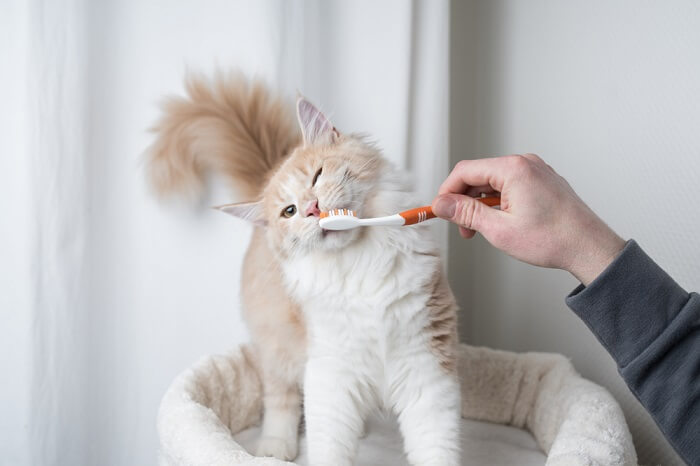
The accumulation of plaque on cats’ teeth plays a significant role in the development of dental disease and bad breath in cats. This article aims to explain the details about cat teeth plaque clearly, so that cat carers learn how to control this, and how to optimise the dental health of their pets.
Background To Dental Plaque

Plaque is the combination of food residue, saliva and bacteria that always coats the surface of the teeth following the chewing of food. Plaque is a soft, semi-liquid substance.
If plaque is not removed regularly, the plaque reacts with minerals in the saliva to form calculus, or tartar, the hard, brown substance that dentists need to remove from our teeth when we are having them cleaned professionally. Veterinary dentists need to remove this hard tartar from the teeth when it gathers.
It cannot be removed by home dental care. That’s why it’s so important to remove plaque regularly: to minimise the need for professional veterinary procedures to remove tartar.
The Problem With Dental Tartar

If dental calculus or tartar build-up is allowed to accumulate, especially along the gum line, many other changes follow in the cat’s mouth. The gums become inflamed (gingivitis), the rest of the lining of the mouth becomes inflamed (stomatitis) then the gums recede, bacterial infection sets in, teeth loosen, and in the long term, periodontal disease, tooth loss and other dental problems follow.
Cats can suffer from a range of other dental issues that can follow plaque and tartar buildup, including resorptive lesions on the teeth (a form of tooth decay), and even the formation of abscesses. For these more severe cases, general anesthesia is needed, along with dental X-rays, dental extractions and other complications. This is why home dental care is so important.
Monitoring Dental Health

The signs of dental disease are not always present in the early stages. Since examining a cat’s mouth can be difficult, regular checkups by your veterinarian are very important.
Good oral care is important for overall health as well as comfort: we know that bacteria can spread from diseased mouths to other parts of the body, such as the heart. And we know that animals with healthy mouths live for longer than pets with dental disease.
The signs of dental disease that are most likely to be noticed by owners include drooling, pawing at the mouth, halitosis (strong smell from a cat’s breath). However, these signs are not always present in the early stages. It can be difficult to examine a cat’s mouth, so regular checkups by your veterinarian are important so that inflammation of the gums and dental disease in cats can be identified at an early stage before it progresses, and an effective home dental care regime can be put in place.
Home Dental Care

The main aim of home dental care is to prevent the accumulation of dental plaque on cats’ teeth and hence to prevent gum disease and tartar buildup.
The Global Guidelines for Veterinary Dentistry, published by the World Small Animal Veterinary Association (WSAVA), recommend a thorough home oral care routine for cat dental care, to optimize oral hygiene, and to ensure that regular effective removal of dental plaque is carried out.
There are two ways of removing plaque: active and passive dental cleaning.
Active Dental Cleaning

It’s best to use a toothbrush and toothpaste designed for use in cats, also a finger brush may be helpful to some cat owners.
Active home care means teeth cleaning by tooth brushing. This can be difficult in some cats, although with patience, it is possible to train many cats to accept this, especially if training is started when cats are young. Tooth brushing (with a cat toothbrush) is most effective for the teeth at the front of the mouth (incisors and canines). It is more difficult to brush the teeth at the back of the mouth (pre-molars and molars).
It’s best to use a toothbrush and toothpaste designed for use in cats, with soft bristles, and an appropriate size of toothbrush handle and head. A finger brush may be helpful to some cat owners.
Human toothpaste should not be used, as the taste is unpleasant to cats, and it has been designed not to be swallowed.
Passive Dental Cleaning

Passive home care means home dental care without active intervention by the owner: it’s most appropriate for the teeth with accessibility issues, especially the pre-molars and molars.
Passive home care includes:
- Dental cleaning cat food, especially dental diets which are special types of dry food (kibble).
- Dental treats
- Chew toys
- Water additives and rinses
It’s important to select the right type of chew products, choosing those that have been clinically proven to be effective (check for approval by the Veterinary Oral Health Council).
Conclusion

If a thorough home oral care regime is put in place, cat carers should be able to effectively control the accumulation of dental plaque in their pets, and hence they will be able to optimise their pet’s long-term oral health.







